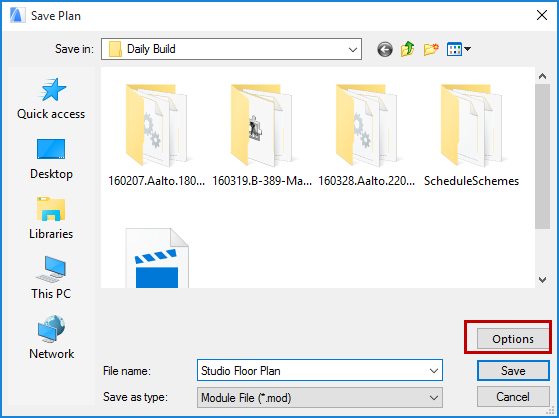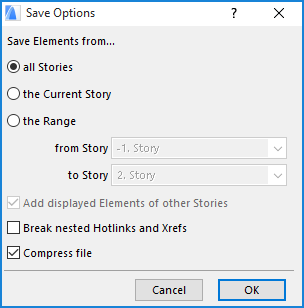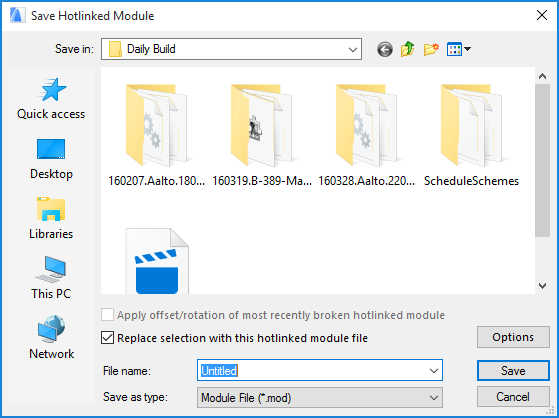
There are two ways to create a module-type file (.mod):
•Save a Project as a Module File
•Save Selected Elements as Module
Save a Project as a Module File
On the Floor Plan, create the set of elements you want to use as a module.
Use File > Save As, and choose the .mod file format.
You receive a notice that the module file will contain only Floor Plan data. Also, only the layers which include Floor Plan data will be saved in module format.

Thus, a module-type file includes Embedded objects, but no Section/Elevation/IE, Worksheet/Detail, or 3D Document data, Library or preferences information; it refers only to attributes actually used by their elements. Thus, a .mod file is much smaller than a .pln file.
Important: If you later open the .mod file and add drawing elements in its Section window (or Worksheet/Detail/3D Document), those modifications will be lost the next time you save the .mod file.
Module-type files can either be placed as Modules or merged into a project through the File > Interoperability > Merge command.
See Merging Files to ARCHICAD.
Merged elements cannot be updated from the source file.
Save Particular Stories in Module File
If the project contains multi-story elements or several stories, ARCHICAD will, by default, save all of the stories as part of the module.
Alternatively, you can save only certain stories in the module: when you save the module using File > Save As, click the Options button in the Save As dialog box to bring up Save Options.


•The default choice is All Stories, but you can choose just the current Story, or a specified range of stories to include in the module file. Any element that falls within this range will be included in the module.
•If you choose either Current Story or a range of stories, you have the option (Add displayed elements of other Stories) to include all elements that displayed on these specified stories, even if these elements are located elsewhere and do not in fact intersect these stories.
•Break nested Hotlinks and Xrefs: If the module file contains any nested Hotlinks and/or Xrefs, you can check this box to break those links if the source files may become unavailable or are no longer needed.
Click OK to create the module file and close the dialog box. You can then place this module file into your project.
See Place Module.
Save Selected Elements as Module
1.Select elements in the Floor Plan. You can select elements from several stories by using the Marquee tool’s multistory option.
2.Go to File > External Content > Save Selection as Module. A directory dialog box will appear, prompting you to save the selected elements as a module file.

•By checking Replace selection with this hotlinked module file, you can immediately replace the selected elements with the module file.
Note: In Teamwork, the “Replace selection...” checkbox is NOT available. The option is available in solo projects only.
•If you have selected certain elements and copied them to the clipboard, you can save a module that will include those elements only: use File > Save As, then choose the Module File from Clipboard file format.
Note: If the selection contains elements that cannot be modified (e.g. they are locked, located on a locked layer or reserved by another user), an alert will warn you. You will then have the choice of either creating the module with the editable elements only, or canceling the operation altogether.
The Apply offset/rotation of most recently broken hotlinked module checkbox is only available in this dialog box if a hotlinked file link has been broken; otherwise it is gray.
See Apply Offset and Rotation of Edited Module.
3.Click Save.
You can then place this module file into a project.
See Place Module.